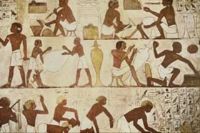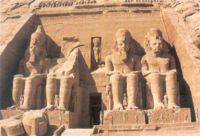Date Of The Exodus
 From Conservapedia
From Conservapedia 


The Exodus of Israel was the event described in the Bible when the Hebrews left Egyptian slavery for the Promised Land under the leadership of Moses. The actual date with which this event took place has been the subject of serious study, speculation, and controversy. Currently, debate has centered on two dates: an early date of 1446 B.C. and a late date of 1290 B.C.
Contents
- 1 Conditions prior to the Hebrew slavery
- 2 Evidence for pre-Exodus slavery
- 3 Early date of 1446 B.C.
- 3.1 The Amarna Letters
- 3.2 David Rohl
- 4 Late date of 1290 B.C.
- 5 References
- 6 External links
Conditions prior to the Hebrew slavery[edit]
The Hyksos, a word from the Egyptian language meaning "rulers of foreign lands" were a Semitic/Asiatic people who invaded the Delta region of northern Egypt about 1720 B.C., making their capitol at Avaris. They ruled Egypt as the 15th Dynasty, and were listed as legitimate kings on the Turin Papyrus, but their rule did not interfere with Egyptian control or politics of the south. They introduced the chariot and the bow, improved battle axes, and better techniques of fortification. Their rule may have been somewhat harsh, as they may have been hated by the Egyptian population as a whole. The Egyptian revolt began under Khamose, and Avaris fell under Ahmose about 1550 B.C., using against them many of the same military weapons and tactics introduced by the Hyksos. The powerful 18th Dynasty was founded by Amenhotep I (1546-1525 B.C.), who came to power after the Hyksos campaign. (Unger, pg. 508)
Evidence for pre-Exodus slavery[edit]
Remaining Semites who stayed behind after the Hyksos were driven out were treated brutally by the next several kings (Thutmose I and Thutmose II), culminating in Thutmose III, who "...made their lives bitter with hard bondage, in mortar, and in brick, and in all manner of service in the field..." (Exodus 1:14). Thutmose III was known as "the Napoleon of Egypt", and who set about conquering large swaths of territory once occupied by the Hyksos and their allies. He was also a great builder who used many slaves in his building projects; the population of slaves included large numbers of Semites, who were hated by Thutmose as a result of the Hyksos period. Archaeologist and historian W.F. Albright confirmed that the Hyksos invasion of Egypt was led by a Semetic people, not Hurrians or Indo-Aryans as some scholars contend; the fact that the remaining population was Semetic help fuel the hatred that many Egyptians felt for the Hebrew slaves remaining in Goshen. (Albright, pg. 44)
Rekhmire, the vizier to Thutmose III, left behind splended wall paintings in his tomb in which scenes of the making of bricks and other tasks are being carried out, similar to the scene in Exodus 5:6-19. Found among the figures in the paintings are foreign Semitic slaves engaged in brick-making, with the hyroglyphic text having them say "He supplies us with bread, beer, and every good thing," while they get a stern warning from the task-masters: "The rod is in my hand; be not idle! (Unger, pg. 333)
Early date of 1446 B.C.[edit]
The early date of 1446 B.C. places the Exodus under the reign of Pharaoh Amenhotep II of the 18th Dynasty, and many scholars contend that this is the correct biblical date. This has been denied by some scholars citing Exodus 1:11 and other evidences, however, a careful survey of the biblical narrative for the Exodus up until the time of Solomon, in addition to extra-Biblical evidence, places the Exodus event during the the mid-fifteenth century B.C., rather then more than a century later.
1st Kings 6:1 states that Solomon began to build the Temple "in the 480th year after the children of Israel were come up out of the land of Egypt," which was during the fourth year of his reign, or about 966 B.C. This agrees with modern archaeologists who established a rough timeframe for Solomon's kingship,[1] making the date of the Exodus to have been about 1446 B.C. This date fits the timeframe as established by the biblical narrative, and chronologists attempting to establish the later date of 1290 B.C. during the reign of Rameses II must thoroughly reject the 1st Kings verse, and by extension reject the chronology of the narrative in Judges 11:26 and the early kingships in Israel as not being able to fit within contemporary history of that time. (Unger, pg. 332)
Contemporary history of Egyptian events also supports the 1446 B.C. date. The pharaoh who refused to allow the Hebrews to leave most certainly would have been Amenhotep II, who reigned c. 1455-1425 B.C. He was the son of the empire builder and conqueror Thutmose III, and Amenhotep lived off his father's largesse. It is also clear from Egyptian inscriptions that the son who succeeded him to the throne, Thutmose IV, was not his first born; this was indicated by the inscription on a slab known as the Dream Stele at the foot of the Great Sphinx which states that the god Amun would give him the throne if he cleared away the sand from the feet of the Sphinx and restore it:
- "One of those days it came to pass that the king's son, Thutmose, came, coursing at the time of midday, and he rested in the shadow of this great god. A vision of sleep seized him at the hour (when) the sun was in the zenith, and he found the majesty of this revered god speaking with his own mouth, as a father speaks with his son, saying: "Behold thou me! See thou me! My son Thutmose. I am thy father, Harmakhis-Khepri-Re-Atum, who will give to thee my kingdom on earth at the head of the living. Thou shalt wear the white crown and the red crown upon the throne of Keb, the hereditary prince. The land shall be thine in its length and breadth, that which the eye of the All-Lord shines upon. The food of the Two Lands shall be thine, the great tribute of all countries, the duration of a long period of years." [1]
The Amarna Letters[edit]
The Amarna Letters, named for Pharaoh Akhenaton's city where they were discovered in 1886, provide a glimpse into the details of an invasion of the land of Canaan by a people called the "Habiru" or "Hapiru"; although some are divided on the matter, many agree that the "Haibiru" are actually the Hebrews just entering the Promised Land and putting fear into the vassals of Egypt in the area.[2] The letters date from c. 1375-1350 B.C., corresponding to the entry of Joshua according to the Biblical timeframe. [2]
David Rohl[edit]
Egyptologist and historian David Rohl created a stir when he published a New Chronology in 1995, essentially re-writing Egyptian history because he believes it was off by approximately 125 years as a result of mistakes made by archaeologists during the late 19th century. While not far off with his date of the Exodus (1446 B.C.), he stated in his book that the pharaoh of the Oppression was Khenefere Sobekhotep IV, and the pharaoh of the Exodus was Dedumose; this based on the writings of a Jewish historian named Artapanus, who wrote Peri Ioudaion (Concerning the Jews), and was cited by the early church historian Eusebius, as well as consulting Josephus in his Antiquities of the Jews (Rohl, pg. 252-280).
Late date of 1290 B.C.[edit]

The late date of 1290 B.C. places the Exodus under the reign of Rameses II of the 19th Dynasty. This is reasoned by scholars based on the following objections:
- It is improbable that Israel would have entered Egypt before the Hyksos period. Countering this argument, it is stated that Abraham entered Egypt and moved about the land rather freely, including personal encounters with the pharaoh during the Middle Kingdom (Gen. 13:10-12); Joseph also was in Egypt prior to the Hyksos, as indicated by the Genesis narrative containing a strong Egyptian, and not Hyksos, style in the writing. There is also the fact that the Hebrews, when they settled in Goshen, were segragated from the Egyptians due to the fact that "every shepherd is an abomination to the Egyptians" (Gen. 46:34), something which under a Hyksos king would not have happened. (Unger, pg. 333)
- The Biblical statement of Exodus 1:11 is supposed to place the event at 1290 B.C. This verse reads "...and they built for Pharaoh treasure cities, Pithom and Raamses", possibly indicating the reign of Rameses II during this time. The fact that the site of the city of Raamses was only called that from 1300 to 100 B.C. is not a settled argument in favor of the earlier date, as the site previously was known as "Zoan-Avaris" where the Israelites had served as slaves years before. Zoan-Avaris also flourished before the Hyksos were driven out at approximately 1570 B.C., leaving plenty of time for the Hebrew slaves to have built the earlier city after they arrived in c. 1870 B.C. during the time of Joseph (Unger, pg. 333).
- The earlier date of the Exodus is disputed by evidence from Transjordan, Debir, and Lachish. The explorations of archaeologist Nelson Gleck demonstrated a gap in the population of this region between 1900-1300 B.C., which according to Gleck indicated that had the Israelites came up from Egypt during the Exodus, they would not have met the Amorites, Moabites, and Edomites which resisted their journey. However, there is nothing in the Exodus story demanding more than a simple, farming economy which left behind little to no evidence for the archaeologist, nor is there any evidence found at Lachish and Debir sufficient enough to set aside the Exodus narrative. (Unger, pp. 333-334)
References[edit]
- ↑ Kitchen, Kenneth A. "How we know when Solomon ruled." Biblical Archaeology Review 27.5 (2001): 32.
- ↑ Waterhouse, S. Douglas. "Who are the Habiru of the Amarna Letters?." Journal of the Adventist Theological Society 12.1 (2001): 3.
- Unger, Merril F. Unger's Bible Dictionary, Moddy Press, Chicago, IL (1966)
- Rohl, David M. Pharaohs and Kings, Crown Publishers, New York, NY (1995), originally published in Great Britain as A Test of Time, Century LTD, London.
- Albright, William F. The Old Testament and Modern Study, Oxford University Press, Oxford, England (1951).
External links[edit]
- The Amarna Letters
- Date of the Conquest, by Bruce K. Waltke
- Did the Exodus Happen? Answering the Skeptics, by Dr. David Lewis
Categories: [Bible Chronology] [Egypt] [Ancient History]
↧ Download as ZWI file | Last modified: 02/27/2023 11:47:47 | 13 views
☰ Source: https://www.conservapedia.com/Date_of_the_Exodus | License: CC BY-SA 3.0
 ZWI signed:
ZWI signed: KSF
KSF